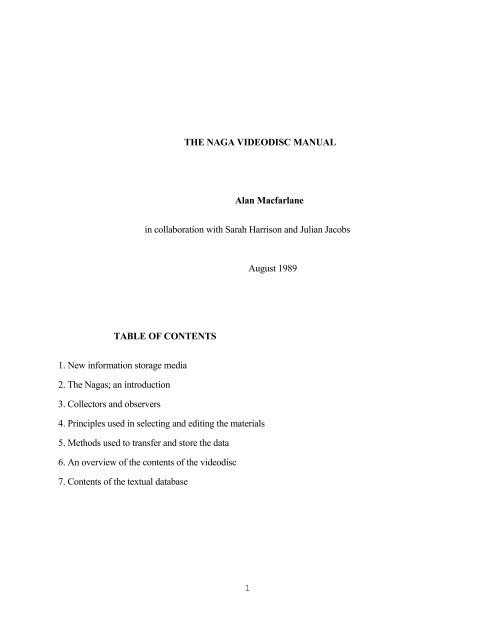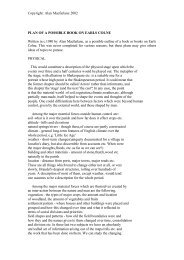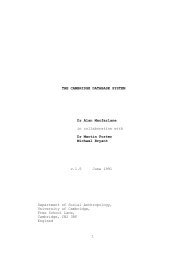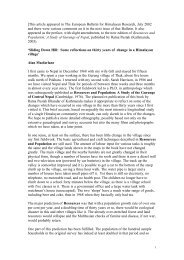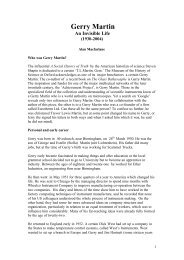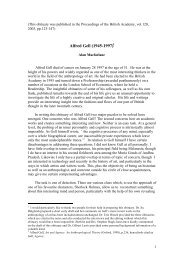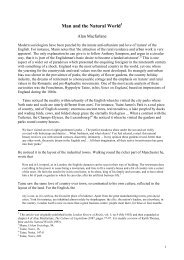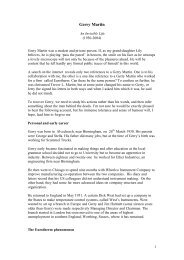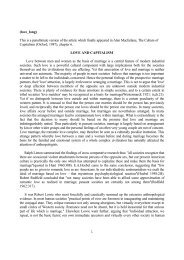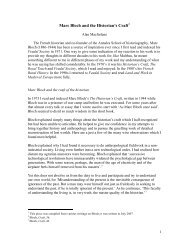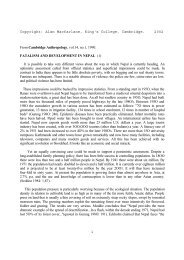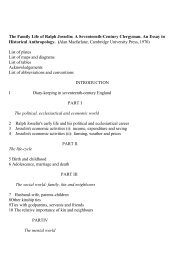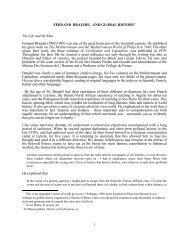THE NAGA VIDEODISC MANUAL - Alan Macfarlane
THE NAGA VIDEODISC MANUAL - Alan Macfarlane
THE NAGA VIDEODISC MANUAL - Alan Macfarlane
You also want an ePaper? Increase the reach of your titles
YUMPU automatically turns print PDFs into web optimized ePapers that Google loves.
CHAPTER ONE. NEW INFORMATION STORAGE MEDIAThe potential of new information storage devices.During the last few years it has become possible to combine media in new ways. Until the endof the 197O's, a computer was still a statistical and textual manipulating device. Even here thecapacities of 'desk-top' computers were very limited. During the 198O's the power and storagecapacity of such computers has increased exponentially.Nowadays, for instance, computers can conventionally have access to stored information onhard disc or optical disc ranging from 2O to 4OO megabytes. Such quantities would only havebeen envisaged with the largest mainframe computers a few years ago, and even then only inspecial circumstances.These desk-top computers are still slower than large 'mainframe' computers. But within a fewyears they will be more powerful and faster than any mainframe of preceding generations.Furthermore, they provide interfaces (e.g. WIMP, windows, icons, mouse, pull-down menus),which are infinitely more flexible and user-friendly than previous mainframes. Likewise the costof storage and computational power is constantly decreasing.These changes, with storage of hundreds of megabytes of direct-access information on opticaldisk storage already announced, presents the possibility of ordinary users setting up large textualand statistical databases on their own dedicated and 'user-friendly' machines. But as the databasesgrow in size and input methods improve, the need for more powerful information retrievalmethods increases likewise.This has led to the proliferation of database management systems, mostly based on the'relational' model, for example the well-known DBase series. These are somewhat blunt tools,however, and this manual will among other things, describe an example of the next generation of'probabilistic' retrieval systems.The potential and problems are increased significantly when we come to the second majordevelopment. This is the increasing possibility of incorporating sound and film and linking this tothe textual and statistical data. We can now begin to envisage the computer as a combinedtextual/visual/statistical tool for manipulating simultaneously words, numbers, images andsounds.There are two developments which have made this possible. On the one hand the increasedstorage capacity allows one to 'digitise', that is to turn into digital form the images and sound(compact disc holds digital sound and it can now hold digital images). The main limitation onthis at present is that a single image requires a great deal of space in such a digitised form, whichprecludes the use of moving film in this format. No doubt compression methods will be found,and some have already been devised to overcome this limitation. The great advantage of havingthe image in digitised form is that it can be manipulated, printed out, deleted or replaced withease. In other words, pictures and sound become like any computer files.2
years. Each stage of the agricultural operation and its close interweaving with ritual and taboowas noted by the observers.Two outstanding features of the varied cultures particularly drew attention, the Naga concernwith death and with the human skull.Although exuberantly alive, what gave real meaning to Naga society was death and the mannerof dying. Despite the absence of written records, through myth and particularly in materialmemorials, the names and deeds of ancestors were to be remembered.Most dramatically, this was done through the erection of massive stones, dragged by teams ofvillagers through the jungle and erected as the culmination of grand 'feasts of merit' to celebratethe power and deeds of great men. The world which was only vaguely remembered in thestanding stones of Europe or the Pacific was still alive among the Nagas.All of Naga life had its ritual aspect: all activities, from simple household and economic tasksup to dancing and feasting, had a mystical or religious significance. The spirits which controlledthe realities of Naga life, disease, human and crop fertility, rain, needed constant attention.The human head, the seat of wisdom and the human soul, was the repository and conductor ofpower. This was true, irrespective of whether the head was that of a child, a man, a woman, aliveor dead. He who owned another's head gained prosperity in this world, the esteem of his fellows,and a guaranteed happiness in the after-world. The best way to own a head was to take one byforce.Forest tribal peoples, for instance the peoples of New Guinea or the Amazon, are often verywar-like. To seize the wealth and labour of other groups is a more congenial way to affluence andpower than by hard work in agriculture. There is no political organisation above the level of theclan or village to prevent war.In this world of a war of all against all, the Nagas added the ritual importance of head-hunting.Life was given its central purpose by the quest for heads. Boys would not become men withoutthe ritual tattooing only to be undertaken after a successful head-hunt; girls would not beattracted to men without the splendid head-hunting dances and decorations. Success and merit inevery field depended on heads.This presented administrators and anthropologists with one of their major challenges. By theturn of the century, they were well aware of the logic of the system and could recognise that ifhead-hunting were rapidly abolished (as it had been in other parts of the Empire) it would be theequivalent of destroying money, markets and the profit motive in a capitalist society. Therewould be little point to life any more.Yet the western conscience could not condone the cruelty, nor was the 'pax Britannica' veryplausible in a world of almost ceaseless feuding. So the observers tried to study, modify andre-shape the institution, while the Nagas tried to incorporate the observers into their world.The mutual relations between these strikingly different, yet admiring and basically tolerantpoints of view, run through the literature. They pose the broadest questions concerning ethicalrelativism, the preservation or destruction of alternative modes of thought and deed, the rights tointerfere. These problems were exacerbated by the growing number of Christian missionaries inthe hills who were trying to convert the Nagas from their supposedly 'heathen' religion, moralityand social customs.Out of this conflict of two civilisations based on entirely different premises there came8
thousands of images and descriptions of the Nagas. This videodisc gives access to many of thoseimages. Since Independence in 1947 there have been great changes and only a part of what isrepresented here has survived.9
CHAPTER THREE. COLLECTORS AND OBSERVERS.The "military" phase of observation.Since we cannot visit Nagaland and in any case the period covered by this disc is long past, weare forced to look over the shoulders of others who lived and worked in Nagaland. We see theNagas through the necessarily distorted mirror of European visitors.Over time, it is possible to divide this observation into two broad and overlapping phases.The first phase (1832 to c.1880) might be termed "military", in which initial contact wasdominated by an attempted pacification in the face of an unorthodox resistance by the Nagas. Inthis phase, where the Nagas represented an unexpected obstacle to the smooth expansion ofBritish political power and economic interests (principally tea), the potential for ethnographicdescription was limited.The Nagas, who had achieved equality with neighbouring valley Hindu kingdoms, did notalways accept the British presence willingly; while their institutionalized violence and lack ofover-arching political organization, made British control difficult to effect. Yet by the end of thisphase a significant body of descriptive writing by surveyors, soldiers and administrators hadbeen built up.The writing was on occasion patronizing and, to the modern eye, racist, and it emphasized theobviously exotic features of Naga society, such as head-taking. But its descriptive thoroughness,in questions of dress, ornamentation, and house-building (features which seemed to make itpossible to identify different groups or even tribes), raised the key question which still informsNaga studies: are the Nagas one people or many ?The "administrative" phase of observation.The second phase, which we might call "administrative", saw overt military control largelyreplaced by a policy of indirect rule through administration. Within the (ever-expanding)administered area, the British guaranteed peace, while setting up structures of courts, schools,taxes, headmen and labour obligations; outside the administered area the British practisednon-interference, except where raiding threatened administered villages or valley tea estates.This policy of non-interference necessitated a need for the most thorough knowledge of thepeople concerned: their indigenous laws and kinship systems, the demands of their ritualobservances, their understanding of social status, their relations with their neighbours, theireconomy and systems of ownership. The variations in these matters between groups of villages,were studied intensively, often under the influence of the then current theories about migrationand social evolution.It is for this reason that the administrative and ethnographic projects were parallel, and indeedthe ethnographic monographs of the 1920s doubled as administrators handbooks. The naming ofthe separate Naga "tribes" (largely on the basis of material culture and language) was effected bythis stage: although a British way of seeing things rather than a Naga one, this classificationcontinues to be important in Nagaland, which since 1962 has been a state within the Republic ofIndia.The Naga videodisc particularly features the work of six individuals, from different points inthis long process of contact and interaction.10
Colonel R.G.WoodthorpeRepresentative of the early imperial, expansionist and military phase, is ColonelR.G.Woodthorpe. Col. Woodthorpe began survey work as an Assistant Superintendent in1871-2, working in the Lushai Hills, and subsequently in the Garo and Naga Hills. His 1882lectures on the Nagas remained a standard work for many years; he illustrated his own writingswith some fine drawings.As the administration became more settled, District Officers were appointed: their on-the-spotexperience was held to be essential to the project of indirect administrative rule.Dr. J.H.HuttonDr. J.H.Hutton, later Professor of Social Anthropology at the University of Cambridge, servedin the Indian Civil Service from 1909 to 1935, almost entirely as an administrative officer in theHill areas of Assam. He was involved, as a magistrate and taxation officer, in a practical way inNaga life. He recorded in detail their customs, languages and social organization. He did thisboth for posterity and, as he saw it, to make it easier gradually and non-coercively to integratethis culture into the British Empire.Through the encouragement of the Curator of the Pitt Rivers Museum at Oxford, HenryBalfour, Hutton began systematically collecting and documenting artefacts for the museums atOxford, Cambridge and elsewhere. He also took a large number of still photographs, made someearly wax cylinder recordings from 1915-19 and took the copious field notes upon which hislengthy and detailed monographs on the 'Angami Nagas' and 'Sema Nagas' were based.J.P.MillsHutton was followed by an equally talented administrative officer, J.P.Mills (1890-1960), laterReader in Anthropology at the School of Oriental Studies. Educated at Winchester, Mills servedin the Naga Hills between l916 and 1938.Inspired by Hutton, by a similar friendship with Balfour and by his deep affection for theNagas, as well as the practical necessity of advising and arbitrating, he collected and analysedwith equal energy. On his numerous trips through the administered and un-administered areas hedocumented the Naga way of life as fully as he could. He added to and complemented thecollections of artefacts, particularly in the Pitt Rivers Museum, Oxford.As a result of the combined efforts of Hutton, Mills and Balfour the collections of materialculture artefacts for this relatively small and isolated group of tribes constitutes one of the finesttribal collections in the world, and undoubtedly the finest in the Pitt Rivers Museum. Thecollection is also superbly documented, with details about the use and origin of most objects.Mills, like Hutton, was a keen amateur photographer and the joint collection of their earlyphotographs comprises about 1500 plate glass slides or negatives. Mills' ethnographicobservations resulted in three lengthy and detailed books on 'The Ao Nagas', 'The Lhota Nagas'and 'The Rengma Nagas', as well as numerous articles, constituting some two thousand pages ofvery careful documentation of these groups. Unfortunately, only a little of his unpublishedmaterials in the form of letters and diaries, have survived.Hutton and Mills are representatives of the colonial officer combined with anthropologist. A11
fully trained and talented example of the new professional anthropologists appeared in the Nagahills in 1936 when Christoph von Furer-Haimendorf arrived to study the Konyak Nagas.Christoph von Furer-HaimendorfBorn in 1909 and educated in Vienna and London, Furer-Haimendorf was for many yearsProfessor of Anthropology at the School of Oriental and African Studies. He was the first in theNaga Hills to live for months at a time practising the new form of 'participant-observation'fieldwork in a single small group of villages. He learnt the language, went hunting, fishing,planting, weeding, dancing and feasting with his co-villagers.While interested in the comparative and theoretical problems of anthropology, he also wished tounderstand and then convey what it must feel like to live in a Naga village, to start to interpretNaga culture from the inside.The feelings, thoughts and interconnections of Naga society fascinated Furer-Haimendorf andhe set out to document and bring back as much information as possible about this very alienworld. He wished to translate this culture into terms that were comprehensible to a Europeanaudience. He tried to do this in four ways.Firstly he used the written word. In the field he kept very detailed diaries totaling about twothousand hand-written pages, covering one year, and in fifteen notebooks a parallel set of moredetailed notes, genealogies and house lists. On the basis of these he published the evocative 'TheNaked Nagas' , a short anthropological work on the 'Konyak Nagas' and a series of articles.Secondly, he added to the collections of artefacts started by others. Thirdly, he made about fivehours of moving 16mm film, both black and white and in colour. As a movie camera was notavailable during his first fieldwork, Furer-Haimendorf returned in 1962 and 197O to make thesefilms, at a time when the Naga hills were closed to all other foreigners.Finally, he was an energetic and accomplished photographer. There remain over two and a halfthousand black and white 35mm photographs (as well as some later colour photographs) of hisyear among the Konyak Nagas. Using a Contax camera fitted with a telescopic lens, he was ableto capture with unusual intimacy the life around him.Ursula Graham BowerA few years after Furer-Haimendorf, but working at the other end of the area among the ZemiNagas of North Cachar, was Ursula Graham Bower.Born in 1914 and educated at Roedean, she first visited a friend in Manipur in 1937 and thenspent some seven years living among Nagas between 1938 and l945. For long periods she waswithout European company and was faced with the advancing tide of Japanese invasion duringthe Second World War. She immersed herself in the culture and language and even led a smallsection of 'V' force irregular troops against the Japanese. Like those before her she sent homematerial culture artefacts to British museums.In an unpublished anthropological thesis she made an analysis of the social organization of theZemi Nagas. In notebooks and diaries she kept a record of her own life and analysed the folklore,language and other features of the southern Nagas. And in her best-selling autobiographicalaccount, 'Naga Path', she tried to convey the experience of a young woman living among theNagas.12
Like Furer-Haimendorf, Ursula Graham Bower was an enthusiastic and gifted photographer.Despite the rationing and disturbances of war, she took over two thousand black and whitephotographs. She somehow procured a 16mm movie camera and film stock and made a series ofblack and white and colour films lasting over an hour and a half. These parallel withconsiderable technical ability her photographs and writings.W.G.ArcherThe final major figure is W.G.Archer, a late example of the colonial officer and anthropologist.Archer had previously worked and written about the tribal art of middle India. When he wasmade Sub-Divisional Officer in Mokokchung in l946, he decided to make a study of Naga artwith a view to publishing a book. He consequently rapidly assembled over 800 photographs,numerous sketches and notes. He was only able to remain for a year, sandwiched between thedevastations of a war which had just finished and the rapid ending of British rule.His insights were complemented by the detailed diary of his wife Mildred, who kept a diary.Both were to go on to pursue distinguished careers in the Victoria and Albert Museum and IndiaOffice Library.13
CHAPTER FOUR. PRINCIPLES USED IN SELECTING AND EDITING MATERIALS.General principles of selection.We now have media (videodisc, compact disc, hard disc) which will hold hithertoinconceivably large sets of visual, aural and textual information. Nevertheless, in practice there isalways too little space, time, energy or interest, so that only part of the materials that havesurvived can be transferred.We have already described in a preliminary way how the minds and interests of the observersabsorbed only a small part of the Naga world into their camera lenses and writings. A seconddistortion then occurs by the action of history and accidents of storage; a great deal has been lost,or is buried in private or public collections in such a way that we were unable to use it.Nevertheless, even with these two filters, a very great deal has survived and this has meant thatwe have had to make some selections from what we have found. Since such a selection isinevitable in any project of this nature and affects the meaning and value of what is available, wemay briefly describe the principles of selection in each major type of material.PhotographsSince there are a finite number of these, and they are of great value, we have tried to includepractically all the photographs we have located. Only a few hundred out of the roughly seventhousand black and white photographs we discovered have been omitted.These were left out on the following grounds: they were duplicates of, or very similar to, otherimages; their quality was poor; they were outside the delimited geographical area; they wereoutside our time span; or they fell on the side of "private experience" as opposed to "publicexperience", in the sense meant by John Berger (About Looking, 1980, p.51).We did not "censor" any photographs because their content was embarrassing or shocking inany way, or might do damage to the reputation of individuals, the British, anthropology as adiscipline, or for other such reasons.This latitude obviously raises important issues, given that the videodisc system is intended foruse in a variety of educational contexts.Many of the images from the colonial era do, after all, portray the people concerned in a waywhich is objectifying, de-contextualizing, or exoticizing. It is undeniably the case that thecamera did contribute to the "normalising gaze", in Foucault's terms, by which a subtle form ofpower was exercised over others by classifying them and making them visible.The Naga videodisc does not attempt to avoid these issues, but, rather, hopes through theassociated tutorials and courseware to encourage a critical attitude on the part of users to thehistorical interaction of anthropology and administration.It must also be said that the antithesis to de-contextualized images is also contained on the discitself, in the shape of some of the earliest, and best, examples of a recognizably "modern" era ofempathetic and contextualized anthropological photography.14
FilmThere were two problems here. First, we found very little film before 1947; but since film is soimportant, we decided to break the temporal boundaries and include movie film taken on twovisits to Nagaland in 1963 and 197O by an anthropologist who had worked in the area in 1936-7.When we included these, we now had some six hours of film.One side of a videodisc will hold only 36 minutes of moving film (in interactive mode), andsince we needed to allocate at least six minutes to the photographs, we only had about thirtyminutes free. This meant that we had to reduce the film at a ratio of 1:12.We spent many weeks going through again and again, whittling away material, trying tominimize the loss of valuable archival footage. The principles we evolved and acted on were asfollows.The first consideration was the content of the moving images. We tried to include that materialwhich was most intellectually and academically interesting. This is a subjective matter, butincludes that material which portrayed events and processes which were most representative,most revealing, most unusual, and illuminated the other still images and texts in the mostsignificant way.The visual images which were unusual included those which were only preserved in thismedium, for instance the eating of dried rats, or a shared joke between anthropologist and Naga.We concentrated on subjects where movement and action were important, for instance dance,games, postures and gestures, rituals, agricultural labour. If long and repeated sequences of filmon the same subject were present, we selected only one or two sequences.The second set of principles was concerned with form. Taking into account the interest of thecontent, we rejected badly filmed sequences, that is to say the few sequences which were out offocus, badly composed, unsteady, from too great a distance and so on. We rejected film that wasdamaged, the colour fading, or otherwise unsatisfactory, unless it was particularly interesting.We preferred close-up shots of detail in most cases to the wider shots of a more static kind,which could be preserved with one or two selected stills. Close-ups are more effective on theintimate television screen.In considering the selection for the videodisc, there was one set of factors which gave us aconsiderable advantage over the person who is undertaking normal editing down from raw film.These are connected to the absolute precise controllability of this new medium.With normal film, one is constrained to save and knit together reasonably long sequences, fiveseconds at least, and often three times that length, just to capture the run up to somethingimportant happening, for instance an immobile man before he starts to run up to do a jump.Again, the action itself, if it is to be appreciated by the viewer and happens rapidly, may need tobe shown at some length, or from several different angles. In other words, a great deal ofredundancy has to be built in to normal editing, since the viewer will only see the images flashingpast once.With videodisc the user becomes the editor, master of the medium. One effect of this is that oneis not constrained in selecting shots for inclusion on the disc by the usual film conventions, suchas keeping the stage line or matching shotsThere is a sense in which film that has been shrunk or contracted in the editing process can be15
expanded again at the viewing stage.This is because it is possible to treat each frame in a precise way. One can take just one shot ofa view, or non-moving group of people, and hold it as an establishing shot for a number ofseconds; if necessary one can easily go back to the start of the sequence and play through in slowmotion to explain in detail what is happening, and so on.In other words, instead of merely cutting a long set of moving sequences into shorter pieces andsticking them in a precise order, one is creating a set of images, some of them still frames, someof them sequences of still frames taken every few seconds, some of them moving sequences.The boundaries between still and moving films blur, and one is able to abstract precisely a greatdeal of the visual information without apparently losing much. It should be stressed, however,that there is a different 'feel' as between a frozen frame and a 'still' filmed sequence.In this way we created out of six hours of film approximately one hundred and fifty movingsequences, each lasting between three and about twenty-five seconds, the average being abouteight seconds. We also abstracted about one thousand "stills" taken out of moving sequenceswhere there was little movement, or randomly every few seconds to capture a series of events, forinstance transactions in the market.ArtefactsHere there is again a problem of selection. There are known to be well over fifteen thousandNaga artefacts in European museums and private collections, at least twelve thousand of them inBritain.To have located and photographed them all would not only have absorbed much of the effort ofthe team, but the final photographs would have used up over a quarter of the total space for visualimages on the videodisc. It would also have given, in some artefacts, hundreds of almost exactduplicates.One general criterion was accessibility. That is to say we confined our work to certain majorprivate and public collections in England, though we knew of others in other parts of the BritishIsles and Europe, not to mention America and, of course, India and Nagaland itself. From thebrief descriptions of other collections, it did appear that we were able to see and select a fairlyrepresentative sample of artefacts.Within the ten thousand or so artefacts which we either examined in themselves, or throughcatalogue descriptions, we used a number of criteria. We sought a representative selection, interms of the types and functions of artefacts and their origins in different Naga groups.We attempted to use Naga criteria of significance rather than our own-that is, to ensure thechosen artefacts did reveal the key features of Naga social structure and belief (status,head-taking, kinship organization and so on).Where there was duplication, we tended to choose artefacts with superior documentation, andleft out those where the condition of the artefact was very poor. We sought to photograph asmany nineteenth century artefacts as possible, on the grounds of their rarity.Such artefacts also were crucial in throwing light on a key research interest - the colonialencounter. What can we learn from the types of artefacts collected, about how the Nagas wereperceived and classified as the colonial era developed?16
We also bore in mind the need to photograph artefacts which would be interesting from acomparative perspective - for example, artefacts indicative of trade amongst Naga groups orbetween Nagas and neighbouring peoples; artefacts bearing strong resemblances to other SouthEast Asian hill tribes; artefacts which, when compared with others, revealed continuity or changeover time.We emphasized artefacts which we knew would tie in well with other material on the disc,such as artefacts collected by administrators or ethnographers whose writings feature prominentlyin the textual database.We sought to ensure that mundane, everyday items were as well represented as the more exoticand aesthetically exciting artefacts. Where there was obvious interest, we photographed fromtwo angles, but constraints of time and difficulty in placing artefacts left this task incomplete.Paintings and sketchesHere there was relatively little difficulty with selection. Since the absolute number was notgreat, in the hundreds, we included all those pictures which we thought could possibly be ofsome interest. Many very simple line drawings were included when they tied up with textualdescriptions, and only very occasionally did we leave out an illustration because it duplicatedsomething else or was so minor and badly documented that it seemed confusing to include it.SoundThe 72 minutes of sound data included on the two tracks of the disc, are an attempt to providevery different kinds of data. We sought to combine recordings of a time breadth to match thephotographs. Thus we included early wax cylinder recordings (1919) and present-day (1987)recordings of songs, with their considerable Christian influence. Examples of several kinds ofinstruments have been included, such as drums, jew's-harps, stringed instruments, as well assinging. Field recordings of conversation (1970) have also been included. This is referred toas 'sound' in the indexes.MapsWe had hoped that we would merely have to photograph the various maps of Nagaland fromthe earliest times up to 1947, including the very detailed Survey Of India maps of c.1910-1945.However, when we experimented with the maps by looking at photographs of the ordnancesurvey maps on the screen, we discovered that this was impossible. However much we magnifiedthe maps by photographing them in tiny sections, the mountainous nature of Nagaland meant thatall we could see were blurry pictures of contour lines, with the odd village name, almostunreadable, dotted among them.We found therefore that we had to re-draw the maps, ending up with 165 sketch maps on thevideodisc. All contours were left off, but otherwise they included rivers, major mountains,borders and the location and names of some 1400 villages and towns which were mentioned inone or more of our photographic or textual sources. The maps were mainly based on the 1:2Survey of India maps of the area.All maps and mapping were subject to considerable errors, compounded in this case by thedifficult terrain, the shifting character of many Naga villages and the immense complexity of17
village names, which can vary radically from author to author, or even within the same author.The maps are therefore, very much to be thought of as sketch maps. They form the basis of"map-walking" software, developed for the project, which allows the user to move north or westto the next map.General principles in selecting texts.The selection of texts was done with two overall considerations in mind, which relate to theinnovative nature of Interactive Video as a technology.The system can be thought of as essentially an archive, in which case one would probably wishto exercise fairly limited editorial control; on the other hand, it is also a teaching resource, and inthis sense does require some attention to including material which is likely to be of use in diverseeducational contexts.The main problem here is not so much one of total available space, but of the effort of dataentry.It will not be long before standard microcomputers have hundreds of megabytes of storageavailable, so there is unlikely to be a long-term difficulty in holding materials. Yet if we considerthe labour not only of inputting material, but then of checking it and indexing it very precisely tomake it useful, it becomes clear that unless one has very large funds and a team of workers over along period, one is bound to reach the limit of what can be fed into the computer.In effect, if we add up all the different parts of people's lives that have gone into this project, itis probable that we had the equivalent of five or six person-years of human labour available.Thus one has to select from the surviving materials. A few of the broader principles of suchselection need to be mentioned.Firstly, we have concentrated, with the major exception of one very long diary in German,entirely on texts in English. Perhaps a tenth of the writings on the Nagas before 1947 has thusbeen excluded for consideration. Secondly, we have tended to concentrate our efforts mainly onthe period between about 191O and 1947, leaving the nineteenth century more selectivelytreated.Thirdly, we have directed much of our efforts to the more intimate and detailed accounts byspecific individuals whose visual materials are available on the videodisc.Major textual collections in the database.Thus we have attempted to collect and put into the computer all the relevant survivingmaterials of R.G.Woodthorpe, J.H.Hutton, J.P.Mills, C. von Furer-Haimendorf, Ursula GrahamBower and W.G.Archer. Added to these are smaller collections from other twentieth centuryauthors.For the nineteenth century we have only selected a few texts, for instance part of theethnographic survey by Dalton, the diary of Godwin-Austen, Woodthorpe's papers and somemanuscripts of Colonel J.Butler.At present, the gaps are as follows. Of the several hundred18
articles written about the Nagas between 1832 and 1947, we have only included a few. Secondly,as far as the official records are concerned, we have only sampled a few of the very extensivefiles. We have included a file on a military expedition, a gazetteer, some official reports.Since the technique we have used is deliberately open-ended, it will always be possible toincorporate more of the materials which undoubtedly exist in the India Office Library and otherarchives both in Britain and India. Little use was made of missionary archives, or of materials onBurma.Omissions and editing.This summary describes the major editorial decisions, to include or exclude a whole class ofdocuments, or whole lengthy text. There are more subtle ways in which one is forced to editdocuments, however.As far as internal editing of texts is concerned, we have only applied two rules. If the material islikely to cause personal offence or political embarrassment to living persons, we have omitted it.In all the files we have included, this has led us to omit probably less than a couple of pages ofmaterial.Secondly, if the material is repetitive or apparently trivial and of only personal interest, we haveomitted this.With regard to the actual materials, we have occasionally corrected spelling or minorgrammatical errors which obscure the meaning, but otherwise we have not changed thedocuments. The fieldwork diaries of Professor Furer-Haimendorf were especially translated forus by Dr Ruth Barnes, an anthropologist and native German speaker. They were checked foraccuracy by Professor Furer-Haimendorf.19
CHAPTER FIVE. METHODS USED TO TRANSFER AND STORE <strong>THE</strong> DATA.Film.We reckoned that about 6 of 8 available hours of film would be of interest, and should beincluded on the disc in full or in "compressed" form. The original film was copied to high qualityvideotape, in the process one copy receiving a burnt-in "time code", which allowed us to watchthe tape and decide exactly which parts we wanted to include on the edit master video-tape.In addition to making time-coded versions for our editing use, the production centre providedthe professional skills of edit suite operators to do the editing work of putting the desired clipsonto the EM videotape. In our case this was extremely complicated, because it involved not onlyrelatively long sequences of film, but also up to a thousand "random" edits (taking, say, oneframe in every 25, to give an idea of what was going on in a sequence without including it infull). If very complicated editing is being done, extra care must be taken to ensure that the fielddominance selected is absolutely consistent throughout or else the possibility will occur of"jumping" frames appearing on the videodisc.Sound.This came in various forms, old 78 r.p.m. gramophone records, wax cylinders, reel to reelmagnetic tape, modern cassettes and high quality quarter inch magnetic tape. All had to betransferred onto the quarter inch tape. Most of this was done within the Audio Visual Aids Unitin Cambridge, though the wax cylinders had to be copied at the National Sound Archive,London. There are two sound tracks on the videodisc so it was necessary to be selective, but therewere few technical problems. There was no usable synchronised sound and film so there was noneed to plan the sound with this constraint in mind.Original photographs.As is common with many historical photographic projects, the images we identified in variouscollections existed in diverse forms; from glass-plate negatives to modern colour prints. Theseall had to be transferred to a single medium.In the case of negatives, we decided that re-photographing as transparencies would be far tooexpensive at the tele-cine transfer stage (given that there were 8000 or so individual images).One option considered was to use a 16mm film camera, mounted on a copy stand above a flashlight source, through which negatives could be fed. This arrangement was mechanically quitecomplicated, and it proved difficult to focus adequately on the image.We decided instead to use a half-frame camera mounted on a Bowens "Illumitrans" copier.The Illumitran allowed for some correction of light balance with each negative, in some casesmaking it possible not only to copy but also to improve on the quality of the originals. Thehalf-frame camera altered the direction of the images. Instead of producing images on the filmlying lengthwise, they were inverted through 90 degrees, to lie across the film and were reducedto about two-thirds of the usual size. In effect, this produced a short roll of film which had theimages lying in exactly the same way as a movie film. Indeed, one could produce short strips, ofusually about 6O exposures, of 35mm movie film.These strips could then be spliced together to create a single reel of 35mm film, with theimages of roughly TV-aspect ratio, easily transferable to video-tape. We used reversal film to20
copy negatives, which produced high grade positive images when developed. We were able todo our own developing of these films, substantially reducing the costs.In the case of positive images (in our case, photographic prints, pencil sketches, sketch maps),we used the half-frame camera (with ordinary transparency film) mounted on a regularcopy-stand, using either an electric light source or daylight. The strips could then be splicedtogether, as described above.A specific problem which it is impossible to overcome arises from the shape of the televisionscreen, that is, its 3:4 aspect ratio of height to width. 'Landscape' negatives are close enough tothe aspect ratios of television to need only a little pruning at the edges. But 'portrait' or uprightoriginals are bound to come out oddly on the TV screen. Here we exercised our judgment in there-photography. If only a part of the portrait is relevant, one can go up close and fill the screen.But in many cases it was impossible to take off much at the top or bottom, and consequently theimage will only occupy the central two thirds of the screen, with subsequent loss of detail. Wedecided to leave roughly equal (white) borders on each side.As for re-framing the landscape photographs, we did a certain amount of this if there appearedto be parts of the picture which contained most of the visual information. In general, however, wetried to be careful not to change the image too much, since the original composition in itself maybe important for future analysts. It was important to bear in mind, however, that TV will alwaystend to crop images, unless they are very carefully taken within the viewfinder's "safe" area. Onoccasions we bracketed two shots together, as "whole" and "detail". Where we were unsureabout the copying of very old or otherwise difficult images, we shot two or three times, atdifferent exposures; but (as explained below) it may prove impractical to edit out the unwantedversions.The half-frame method has a number of advantages. But there are three potential hazards. Oneis that if a single mistake is made in the splicing, the entire reel after that point will be "out" bythat amount, and the resultant videotape master will be useless. The second arises from this needfor care with splicing.For non-specialists, the less splicing, the better. Therefore, it becomes inadvisable to thinkabout "splicing out" all your faulty images, which will doubtless figure here and there in thehalf-frame film strips. The resulting videotape will, therefore, include your "mistakes" and indeedyour codes for where the constituent strips begin and end (without these, it may be difficult torelate any individual picture to its index record when it appears on videotape and ultimately onvideodisc). "Mistakes" will of course be "edited out" to some extent in the system software (thatis, query-based searching will never take the viewer to a faulty image); but random flickingthrough the disc with a keypad will mean that users will see mistakes from time to time.Third, attention must be given to accurate centring of the images. In many cases (e.g.landscapes), this may not be important, but where single objects or portraits are concerned, it isas well to anticipate a possible slight "left bias" in the tele-cine process. That is to say, thetele-cine process expects the left side of any film strip to contain a sound track. This will ofcourse not be the case with half-frame film. But potentially this means that the tele-cine processonly scans 90 per cent of the film width, missing out the 10 per cent of "audio" to the left, whichin our case is very much part of the picture.The effect is that, as is visible in our disc, the "true" centre of the original film appears to beshifted by ten per cent to the left on the videotape (and therefore on the videodisc). To anticipateand correct this possible bias, it is essential either to ensure that full-width scanning will beavailable to you, or else to centre the original photographs ten per cent to the right of true centre,when you look through the view-finder, and to ensure that nothing of value remains within the21
left ten per cent area.Artefacts.Our project first concentrated on material culture objects from the Naga Hills. This is the onlypart of the disc featuring original new material photographed by the project. Some of the earlierimages on the disc relate to the period when we were developing the technique and remainsomewhat unsatisfactory.We were advised to use natural daylight as far as possible, and we did so in almost all cases.The exception were a few very large artefacts which could not be moved outside or properly litby daylight. We also decided that, since our aim was mainly to provide a neutral and preciserecord of the artefacts, we should try to take them all from a uniform angle. This was almostalways from above, using a copy-stand set-up. The exceptions were the few artefacts whichbecause of their shape or size could not be photographed thus. We photographed against avariety of backdrops which we made. It is essential to anticipate cut-off during later stages of thetransferring process, and therefore to frame the object in the view-finder within the "safe area",leaving a generous border.We tried to take a photograph of the whole artefacts from the top or front, as appropriate, withextra photographs of other angles or details or close-ups using a macro lens, if this seemednecessary. We decided to keep out measurement rulers, but measured each object so that theinformation could be available in the index entry about the image.These colour slides were then transferred by the process described below, with "tariffing"(colour balancing), to videotape. Depending on the nature of the objects, the logistical problemsin the museum or archives we were working in and the number of persons working, it is probablyroughly the case that with some help from the curators in searching for and getting hold of theartefacts, two people working together could photograph and index between twenty-five and fiftyobjects in a full working day. (This was working under pressure, with relatively portable objects,and assuming no hitches. The desired quality of the end product will of course also affect thiscalculation.) These colour photographs were developed by the University of Cambridge AudioVisual Aids Unit, while the black and white half-frame photographs were developed by one ofour team.Transferring black and white photographs to master tape.At the BBC Enterprises Centre, we arranged to have our long reel of half-frame filmtransferred to c-format videotape. A trade-off had to be made, between target quality and cost. Itis perfectly possible to have each frame checked ("tariffed") for colour and contrast and forconsiderable changes to be effected, improving the quality of the originals. But this would cost avery great deal of operator's time (at £80 per hour). Instead, we opted for "batch" control, bywhich a certain amount of checking for colour and contrast was done for a series of photographsat a time.It is at this point that the original quality of half-frame photography matters. Batch monitoringwill only be of much use if the half-frame photography is done carefully enough to produce afairly uniform standard of image, without wide variations of brightness and contrast. If there islittle tariffing to be done, this process is remarkably fast: transferring from film to videotape at25 frames per second (standard moving film speed) means that 8000 frames will take about 6minutes. It also appears to be the case that relatively minor adjustments in exposure in thetele-cine process for colour images produce a larger difference in the final videotape rendition22
than is the case with black and white images.Transferring colour slides to master tape.By choosing slide transparency for our photography of museum artefacts, we allowedourselves the option of slide-by-slide colour monitoring to improve quality during the process oftransferring to 1-inch c-format tape. This process involved some very time-consuming mountingof slides (in our case, about 1000) in special individual mounts and racks, and was also expensivein terms of an operator's time. A slightly less expensive version of this process is available, inwhich the transparency film is fed in as continuous strips (i.e. not individually mounted), but thisdoes not allow individual frame colour control.Pressing the videodisc.The production centre not only assembles the above material onto the EM tape, but alsoincludes credits and title (if any) and standard audio and video test signals and lead-in andlead-out tape, after which the EM tape can be sent to the disc pressing plant. At this stage, weopted to produce a "check disc" made in essentially the same way (i.e. an acrylic, PMMA, coatedwith a layer of aluminium) but with slightly cheaper materials, and most suitable to one-offproduction rather than large numbers. It is much less robust than standard laservision videodiscs.This allowed us to check the disc and determine if there were any errors. This proved a valuableexercise, since certain errors were indeed discovered, which we could then correct, and it allowedsome new material to be inserted at the end of the disc. We had this check disc made at Gesco,Paris; the process took an hour. The quality is undoubtedly inferior, particularly on the first partof the disc, and users thinking of using only this cheaper process should try and ensure thatmoving film rather than stills appear on the first part of the disc, so the loss of quality will be lessobvious.Once satisfied that corrections to our edit master had been made properly, we then pressed 100copies of the disc at Telemedia (West Germany), mainly on the grounds of slightly morecompetitive rates than the other European producer, Philips (Netherlands). The turnaround is intheory 3 weeks. The fact that errors were corrected and additions made, before pressing this finaldisc, necessitated considerable and non-uniform changes to our database numbering of records.Textual materials.The transfer of the textual information is a very long and time-consuming business butcompared to the videodisc transfer, the methods are relatively simple and well-known. Theprinted books which were of sufficiently high quality to be scanned by a computer were fed in byoptical character recognition methods. It was a relatively slow process to input about 3000 pagesof text, which all had to be carefully checked, since the computer found it difficult to distinguishcertain letters, for instance i and l. Nevertheless, it was much less of an effort, and much cheaper,than typing in the material. It worked out at about twelve pence a page.The rest of the material was either in manuscript form, or the printing was too poor for presentscanning devices. This was typed in using conventional word-processing packages and data entrymethods, over a three year period. Often the manuscripts were very faded, sometimes jumbled incontent, excruciatingly badly written, or presented other difficulties. One key text of over15O,OOO words had to be translated from the German. The texts were then held for editing,indexing and later dissemination on the Cambridge University Mainframe computer, both ondisc and backed-up onto tape. This will finally constitute a textual database of between six andeighth thousand pages of information, including indexes; between thirty and fifty megabytes on23
the computer hard disk.24
CHAPTER SIX. AN OVERVIEW OF <strong>THE</strong> CONTENTS OF <strong>THE</strong> <strong>VIDEODISC</strong>.The videodisc contains a selection of images of different kinds. Here is a preliminary overviewof the types of material on the disc, with an accompanying 'map' of the videodisc showing wherethe various materials are.There are some 135O colour photographs of selected ethnographic artefacts from the PittRivers Museum in Oxford, the Museum of Mankind, London, the Museum of Archaeology andAnthropology in Cambridge and other public and private collections. These include photographsof a selection of weapons, tools, ornaments and textiles. These can be located as 'artefacts' in theaccompanying videodisc map, and cover the period from about 1870 to the present day.There are copies of some 4OO drawings and paintings between the 1847 and 1947 taken fromdiaries, fieldnotes, printed and other sources, varying from full colour portraits to small sketchesof a decorative pattern. They include designs, patterns, human faces, house types, flora and fauna.They are labelled 'sketches' in the videodisc map.There are 165 maps specially re-drawn for the videodisc. These indicate the position of morethan a thousand villages, towns, rivers and mountains in the Naga area which are referred to intexts and pictures. These are indicated as 'map' on the videodisc map.There are about 7OOO black and white, and a few colour, photographs from the 188O's to1948. These cover all aspects of Naga life, art, architecture, crafts, rituals, sport, family life,marriage, war, head-hunting, agriculture, fishing, colonialism and many others. All majorsub-groups of the Nagas are covered. They come from public archives and private collectionsand are referred to as 'photographs'.There are over 15O sequences of moving film and another thousand or so still frames extractedfrom 16mm colour and black and white moving film shot between 1938 and 1970. These covermusic and dancing, war and head-hunting, the agricultural cycle, fishing, arts and crafts, bodydecoration and tattooing and many other topics. They are referred to as 'film'.Finally, there are 72 minutes of recorded sounds from Nagaland, from wax cylinder recordingsmade in 1916 to some contemporary devotional music. The sound of various instruments, suchas drums, jew's-harps, primitive string instruments, as well as solo and communal singing bymen and women, illustrate some features of the musical culture of the Nagas.A brief table of contents, or 'videodisc map', in sequential order, is given here.Framesshort description1-13 titles and credits14-1325 artefacts: colour photographs of museum artefacts,some sketches, field photographs, paintings, photographs of plants133O-7418 films: 'The Man Who Hunted Heads', TV film byChristoph von Furer-Haimendorf; colour, 19707419-1OO5 films: of Wanchu Nagas, by C. von Furer-Haimendorf,1962; black-and-white10006-22184 films: of Zemi and Tangkhul Nagas, by U. Graham Bower, 1938-45;25
colour22185-25199 films: of Kabui and Tangkhul Nagas, by Ursula Graham Bower, 1937-40;black-and-white25200-26251 films: of Kabui and Tangkhul Nagas, by UrsulaGraham Bower, 1937-40; colour26252-43164 films: of Zemi and Konyak Nagas, by Christoph von Furer-Haimendorf,1970; colour43165-46122 films: of Wanchu and Konyak Nagas, by Christoph vonFurer-Haimendorf, 1962; colour46123-46331 photographs: stills from von Furer-Haimendorf films; colour andblack-and-white46332-46363 photographs: plants in Botanic Garden, Cambridge; colour46366-464O5 artefacts: from a private collection; colour464O7-46426 photographs: by Sir Robert Reid, c.1937-39, from India Office Library,London; black-and-white46429-46438 paintings: by Col. R.G. Woodthorpe, 1876, from Library of Museum ofMankind, London; colour46441-46444 photographs: by Dr. H.R. Hall, early 20th Century, from Museum ofMankind, London; black-and-white46446-46459 sketches: from private papers of Ursula Graham Bower; black-and-white4646O-46474 sketches: from articles46475-46579 sketches: from private papers of W.G. Archer; black-and-white4658O-46591 sketches: facsimile pages from source materials; colour andblack-and-white46593-466O8 sketches: of animals, from D. Macdonald ed., The Encyclopaedia ofMammals I&II, Equinox Books,1984; colour466O9-46693 sketches: from diary of Henry Balfour, 1921-22, from the Pitt RiversMuseum Archive, Oxford;black-and-white46696-46762 sketches: from diary of Col. R.G. Woodthorpe, 1876; from Pitt RiversMuseum Archive, Oxford; colour46764-46785 sketches: from H.H. Godwin-Austen diary, 1872-73; from Library, RoyalGeographical Society, London;black-and-white47687-46850 sketches: from J.H. Hutton, "Two Tours in the Naga Hills," 1923;black-and-white46852-46959 illustrations: from books and articles; colour and black-and-white46961-47007 sketches: of animals, from S.H.Prater and P.Barrel, "The Book of Indian26
Animals",1965; colour47010-47177 maps: sketch maps of Nagaland47179-473O5 photographs: by C.Pawsey, 1937; C.A.Gourlay; F.Engledow;L.E.Macgregor; from Centre for South Asian Studiesarchive, Cambridge; black-and-white473O6-4773O photographs: by J.H.Hutton, 1913-23, from theArchive, Oxford; black-and-whitePitt Rivers Museum47731-47837 photographs: by J.P.Mills and J.H. Hutton, 1913-23, from the Pitt RiversMuseum Archive, Oxford;black-and-white47838-48159 photographs: by J.P.Mills, c.1920-36, at School of Oriental and AfricanStudies, Dept. of Anthropology, London; black-and-white4816O-48995 photographs: by W.G.Archer, 1946-48, from private collection;black-and-white48996-51638 photographs: by Christoph von Furer-Haimendorf, 1936-7, from privatecollection; black-and-white51639-51958 photographs: by Charles Stonor, 1946-48, fromthe Pitt Rivers Museum Archive, Oxford; black-and-white51959-53623 photographs: by Ursula Graham Bower, 1937-46, from the Pitt RiversMuseum Archive, Oxford; black-and-white53624-53767 photographs: sketches from tour diaries; photographs from articles andbooks; photographs of Nagalandby S.Khilnani, 1987Sound materials on the videodisc:Audio track 100001-23250 All India Radio excerpts23300-49550 Christoph von Furer-Haimendorf,1970 field recordings9620-51340Field recordings, 1986-7,field recordings, devotional songs:49620-50610 tape 2, track 1 ;50670-51340 tape 2, track 451350-52600Ursula Graham Bower, 1986,at Cambridge:51350-52100 interview ;52140-52600 song52620-5399927
J.H. Hutton, 1919,wax cylinder recording no. 7Chang songAudio track 200001-33200Chants des tribus, Paris00001-06750 A/2 Sema06850-11550 A/3 Sema11650-17550 A/4 Sema17700-21150 B/2 Sema21200-24850 B/3 Zeliang24860-29300 B/4 Zeliang29350-33200 B/5 Zeliang33250-42500Field recordings, 1986-7,33250-35910 tape 1, Khonoma35950-42500 tape 442520-49750J.H. Hutton, 1919 wax cylinder recording: 42520-46020 no.3, "hoiyi olli", Angami song146050-49750 no.9, "lipeli", Sema song49800-53750Angami Naga Students E.P.:49800-53750 "Nyokro Kevupfe"51780-53750 "Loswulu"28
CHAPTER SEVEN. CONTENTS OF <strong>THE</strong> TEXTUAL DATABASE.There are a number of different classes of written records which provide the backgrounddocumentation for the visual images and are of value in their own right. They make it possible totrace the process of documentation of Naga culture from the first, fairly random, fieldnotes ordiary jottings, up to the final, polished, published book.There are a number of manuscript daily diaries kept by soldiers, surveyors, colonial officials,anthropologists and interested observers.From the earliest mid-19th century reports and diaries of Woodthorpe, McCulloch, Butler andGodwin-Austen through the illustrated museum curator's diary of Henry Balfour in 1922, and thedetailed anthropological diary of von Furer-Haimendorf in 1936-7, to that of Mrs. M.Archer in1947, there are the equivalent of over a thousand printed pages of diary material. These providethe most intimate and revealing reactions of the visitors to the Naga Hills.There are extensive fieldnotes taken by anthropologists and colonial officers, describing everyaspect of Naga life, from rituals and myths, to genealogies and house lists. These can becross-referred to the diaries and provide a solid body of ethnographic description and preliminaryanalysis. The fieldnotes constitute the equivalent of over 75O pages of printed material.A number of those who visited and worked in this area wrote letters to their family and friendsin England. A selection of these letters, for instance those exchanged between J.P.Mills,J.H.Hutton and Henry Balfour, have been included. They describe some of the practical andtheoretical problems that lay behind observing and collecting materials.Colonial officers were required to make detailed reports on their tours of duty throughNagaland. These were then used by the government to provide the background foradministration. Over one hundred such tour diaries made by J.H.Hutton, J.P.Mills and othershave been transcribed, giving insights into colonial administration and the mentality of theobservers. They constitute the equivalent of some 4OO pages of printed materials.A considerable quantity of reports, surveys, gazetteers, and other official records werepublished by the British administration over this period. Much of this is in the India OfficeLibrary, and selections relating to the Nagas have been transcribed and included. This gives astrong impression of the official and secret activities of the British Empire in this corner of itsterritory.The final major category is the extensive scholarly materials published as books or articles inlearned magazines. Most of the books on the Nagas in this period are now rare, expensive anddifficult to obtain.For this reason they will be put into the textual databasewhen the average store on a micro-computer becomes large enough. Individual monographs byHutton, Mills, von Furer-Haimendorf, Graham Bower, Hodson, and Smith will be put in thetextual database and indexed by paragraph and by topic. They include most of the major Nagasubdivisions.A preliminary list of what is included in the first issue of the data is given here.Textual materialsChristoph von Furer-Haimendorf:29
field diaries, 1936-7; field notes, 1936-7, 1970;J.P.Mills:letters, 1919-36; tour diaries, 1927, 1928, 1936;J.H.Hutton:letters, 1916-38; tour diaries, 1917-35;U.Graham Bower:field diaries, 1937-40; letters and field notes, 1937-47;thesis, 1950;W.G.Archer:field notes, 1946-48; tour diary, 1946-47Mildred Archer:diary, 1947Col.R.G.Woodthorpe:tour diary, 1875; Report of Survey Operations, 1875-76H.Balfour:diary, 1922-23K.Cantlie:memoir, 1919-20; tour diary, 1919-20;H.H. Godwin-Austen:tour diary, 1872-73Colonel J.Butler:tour diary, 1870-73P.J. Maitland:Naga Hills Expedition, 1879-8030
CHAPTER EIGHT.CREATING FILMS AND PROGRAMSCreating films and programsWith some idea of the materials available and how they can be retrieved, we can now considerhow the visual and textual materials can be combined, re-ordered and enriched creatively in orderto construct new materials. The searching power of the computer has been illustrated, but itsability to instruct the videodisc to carry out a series of logical steps provides an added dimensionto its use. There are two main stages in this creative process. The first is to work out a logicalsequence of actions, a script or 'flowchart', which will explain what the film or program is about.The second is to translate this into an 'authoring' language that will communicate with thecomputer.There are various flowcharting conventions, and as long as the user finds them helpful, what ischosen does not matter greatly - unless one is sending the flowchart to someone else to do theprogramming. In the latter case, a set of agreed conventions such as those set out by Pioneer, areuseful. It is possible that while for elaborate programs one will need some such pictorialflowcharting methods, for simpler users, a script can be written in ordinary words.The second task is to turn one's script into something the computer can understand, through ahigh-level 'authoring' language. A number of such languages are available (and are reviewed in"Authoring Packages, A Comparative Report, Gill Strawford, National Interactive VideodiscCentre, London, 1988), of which 'Microtext' is among the best known. All of these can be usedwith this videodisc and database. But since most of them are very general, and hence have to bequite complex to deal with all possibilities, we have decided to develop our own. This isdeliberately kept very simple, so that a user can sit down and begin to write programs within afew hours.A brief preliminary overview of the system, Videoscript, the authoring system developed forthis Project by Michael Bryant, and currently working with an 'Amiga' microcomputer with a'genlock', may be given.Videoscript; an authoring language.Videoscript allows the user to write a series of commands, each on a separate line, as a file(using an editor or word-processor). This file is then checked and compiled, and can be run toshow an interactive film. Versions can be written to work on two screens, one showing thevideodisc picture, and one the computer graphics, or on one screen, mixing the signals onto thecomputer screen with a 'genlock' device.There are three types of line. Lines starting with a semi- colon (;) are interpreted as theprogrammer's comment and are ignored by the computer. Lines starting with a colon (:) areinterpreted as labels. That is, one can set a label somewhere in a script, and then by inserting thatlabel name elsewhere, or asking the computer to 'goto' that label, create loops and sub- programsin the script. Examples will be given. Lines that are blank are passed over. If a line ends with aback-slash (\), it is interpreted that it is joined onto the next line. This is necessary when one istyping in text that goes on for more than one line.In all cases other than the above, each new line is expected to start with a command word,followed in many cases by one or more extensions, for instance 'slow backwards', where 'slow' isthe command and 'backwards' the extension.There are two separate devices to control, the videodisc player and the computer. The controlis exercised by writing a COMMAND (we shall use capital letters for commands, though they31
can be in either case) and in many cases an 'extension' to that command (which we have put inround brackets below). For example one might have a line with find 2000, which has thecommand find, and the extension 2000, meaning the videodisc number.CONTROLLING <strong>THE</strong> <strong>VIDEODISC</strong>FIND (frame number) - finds frame number and enters still modePLAY (forward, backwards) TO (frame number)SLOW (forward, backwards) TO (frame number)SLOW SET (speed number, between 2-255, in units of 2Oms)STEP (forward, backwards) - advances videodisc one frameWHEN (frame number) - videodisc to report when reached that frameAUDIO (1 or 2 - sets channel, on or off; e.g. audio 2 on )VIDEO (on or off; turns off videodisc display in 2 screen versions; for 1 screen version seeSHOW below)CONTROLLING <strong>THE</strong> COMPUTER DISPLAYCLEAR SCREEN - clears screen to current background colourPOSITION - sets the current position where writing will appear, vertically (v) and horizontally(h). The latter not yet implemented. The screen is 256 dots (pixels) high, so the extensioncommand 'v 125' would start the text about halfway down the screen.MARGIN - sets the current left or right margins for printing texts; the screen is 64O dots (pixels)wide , so the following commands 'margin left 5O' 'margin right 59O'(ie. 59O dots from the realleft margin) would leave a border on each sidePRINT - prints on the screen whatever comes immediately after it; if the text is more than oneline (it must be less than 800 characters, about 12O words), each line except the last must endwith a \ character, as explained above. The text is automatically 'word-wrapped' within the setmargins.CENTRE - centres any text coming after the commandFONT - (1 or 2) - 1 is 12 dots high, 2 is 15 dots high)COLOUR (text or background ) - sets the current colour; the standard colours are:1 - pale grey 2 - pale cyan 3 - dark brown 4 - lavender 5 - dark blue 6 - dark red 7 - salmon pink8 - blackCOLOUR RESET - restores the original default coloursSHOW (mix, computer, video) - mixes the signals, or shows just the computer or videodiscoutput32
These commands are written in sequential form within a script, which itself requires certaincommands and extensions.SCRIPT FLOW COMMANDSPAUSE (number) - cases the computer to pause before executing the next command, numbersare in tenths of a second.GOTO (label name) - causes computer to go to a set label, and to continue from the command onthe line after that label. This and the next command, with the setting of labels (always startingwith a colon, e.g. :label or :here, enables the setting up of potentially infinitely complex loops andsub-routines.INSERT (label name) - as above, except the current script position is remembered and returnedto once the inserted block has been executedRETURN - causes a script execution to continue after an inserted block as aboveEND (script, programme) - marks the end of the relevant section of the script or programme; endscript means that any text following it is ignored unless an 'Insert' points to it; end programmeleaves a pause of 1O seconds, then returns to the initial position.As well as ordinary, sequential, scripts, it is possible to write interactions, where the user canmake choices and 'branch' in different directions. This is done by a set of interaction commands.INTERACTION COMMANDSINTERACTION - starts an interactive sequenceHEADING (followed by up to 2 lines of text), writes a heading for the interaction choiceCHOICE (number 1-5; text) - sets up a choice box, with up to two lines of text against it, asub-heading or question. If more than five choices are needed, one or more of the boxes can takeone to further choices.END - ends the interaction sequenceThe scripting system is put into operation as follows. The file which contains the script, whichshould always be given a filename with a 'vs' sub-name, e.g. fishing.vs, is first checked andcompiled. This is done by the following command:vcon fishing.vsThis will report any logical errors in the file, which will need to be corrected if they haveprevented a 'run' file being created. If there are no serious problems, one then types:vrun fishingAt this one will be shown a screen with a choice. Since the run file is already mounted, one clickson 'run', and the programme one has created is shown.33
In order to make it easier to understand this, we may give a few very simple examples (these maybe run on the videodisc). The first is very short:-clear screencolour background 5colour text 2font 1margin left Omargin right 64Oposition v 8Ocentre my first scriptpause 3Oclear screencolour background 7colour text 3font 2position v 8Ocentre this is just an examplepause 3Oend scriptend programmeA full version of the Manual is available.Please note also that the full account of the information retrieval system that works with this data,the Cambridge Database System, is available in a separate Manual.34


